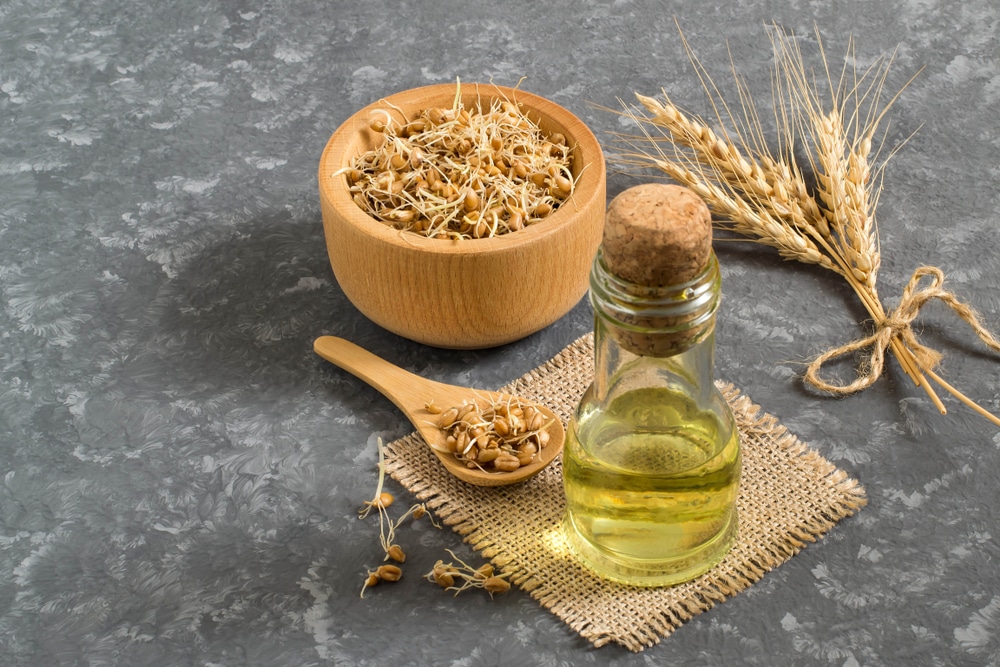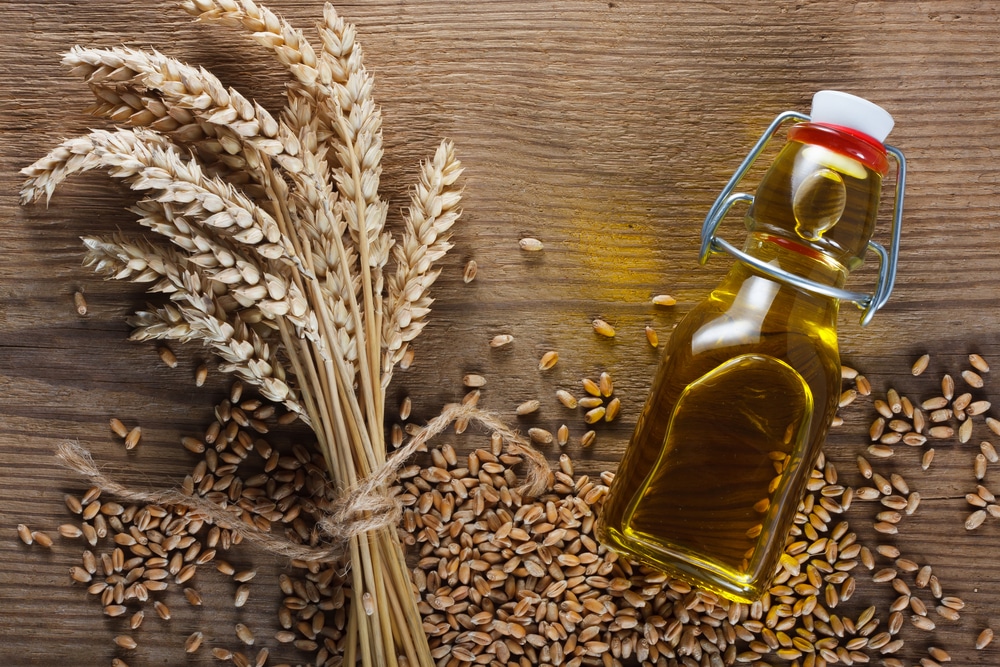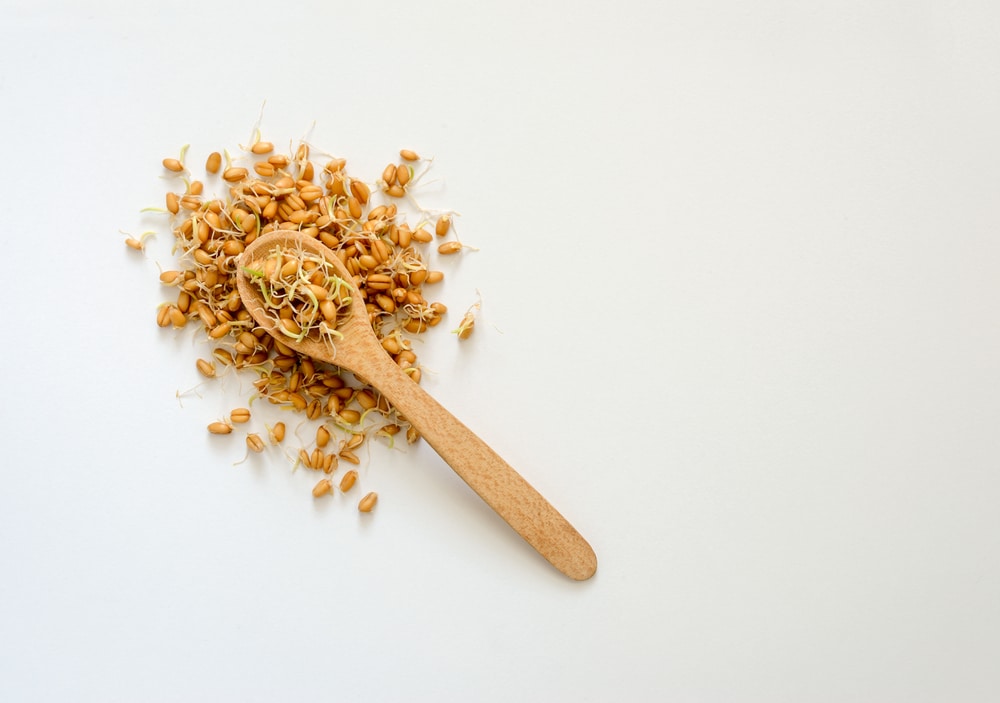Whether you love it, hate it, avoid it or eat it without a care in the world, you know what wheat is, its benefits as well as its potential downsides. But, have you ever heard of wheat germ? In the health world, wheat germ is slowly but steadily growing in popularity with more and more people advocating its health benefits. So what is it and how might it improve your health? In today’s article we are going to take a look at wheat germ nutrition, its potential health benefits and the side effects of adding it to your diet.
What Is Wheat Germ?
Along with the endosperm and bran, wheat germ is one of the three edible parts of a wheat kernel. In the kernel, it is the embryo and plays a major role in the reproduction and production of new wheat.
Because of the short lifespan of this tiny embryo, most refined grains often have this part removed so they can have a longer shelf life. With that being said, this cereal grain can be found either raw, fermented, toasted, or extracted as an oil.
What Nutrition Is In Wheat Germ?
According to Medical News Today, knowing the nutritional value of foods can help people make better dietary choices to reduce the risk of chronic illnesses, avoid nutritional deficiencies – or having too much of a nutrient – and even avoid allergies.
The World Health Organization further stresses the importance of nutrition by stating that it is a critical part of development and good health. Having good nutrition means having stronger immune systems, normal growth, development and aging, safer pregnancies and childbirth, healthy weight, reduced risk of chronic diseases – basically overall good health and wellbeing (7).
Here is 115 g (1 cup) of wheat germ nutrition data according to the USDA (17)
- Calories in wheat germ – 414 kcal
- Protein – 26.7 g
- Fat (total) – 11.2 g
- Carbohydrates – 59.6 g
- Fiber – 15.2 g
- Calcium – 44.8 mg
- Magnesium – 275 mg
- Phosphorus – 968 mg
- Potassium – 1030 mg
- Zinc – 14.1 mg
- Manganese – 15.3 mg
- Selenium – 91.1 µg
- Folate – 323 µg
- Cholesterol – 0 mg
- Iron – 7.2 mg
As for other wheat germ nutrition details, this cereal grain also has traces of important minerals and nutrients such as copper, niacin, vitamin B6, thiamin, and riboflavin. As if this was not enough, you can also find traces of all the 9 essential amino acids – namely histidine, isoleucine, leucine, lysine, methionine, phenylalanine, threonine, tryptophan, and valine – as well as other non essential amino acids, all needed by our bodies for proper functioning (17). Wheat germ is still not considered a complete protein, however, because it doesn’t contain sufficient amounts of all 9 essential amino acids, but it does contain them all in at least trace amounts.
Read More: Sorrel Nutrition Facts, Health Benefits, And Side Effects
What Are The Benefits In Wheat Germ?
Here are the potential benefits of adding wheat germ to your diet
-
May Reduce The Risk Of Cancer
Because the root cause of most cancers is still unknown, prevention is always better than cure. One animal study published in 2019 stated that the antioxidants found in this cereal grain may have anticancer activity (2).
-
May Improve Quality Of Life In Cancer Patients
For those already suffering from this disease, adding wheat germ to their diets could drastically improve their quality of life. According to a study in the JBI library of systematic reviews, Avemar – an extract of fermented wheat germ has been studied in animals and human cell lines as a potential anticancer therapy. Limited human studies also suggest a role for Avemar as an adjunct to conventional cancer therapies, possibly reducing side effects of the treatments and improving quality of life for patients (11).
-
Rich In Vitamin E
According to WebMD, this cereal grain has high levels of Vitamin E. One tablespoon of wheat germ oil has about 20.3 mg of Vitamin E (13). Also known as tocopherol or alpha-tocopherol, this is a nutrient that is incredibly useful to the body due to its antioxidant activity.
The functions of this nutrient include preventing oxidative stress, protection of cell membranes, and the regulation of platelet aggregation and protein Kinase C activation. Studies have also shown that this vitamin can support your immune system. It also helps reduce your risk of cardiovascular diseases, cancer, cataracts, and Alzheimer’s (13).
-
Rich In Fiber
Like all other complex grains or carbohydrates, wheat germ is high in fiber. A high-fiber diet supports healthy and regular bowel movement, aids in blood sugar control, helps lower LDL cholesterol levels, promotes gut health, helps with weight loss, and may even reduce your risk of colon cancer (9).
-
May Relieve Cramps And Symptoms Of Menopause
For any premenopausal women and women who go through painful cramps during their periods, research shows that wheat germ extract or supplementation with wheat germ might help relieve your symptoms (12, 3, 10).
Looking for a way to break the vicious cycle of weight loss and tone up all the jiggly parts? Watch the extra pounds fly off and your muscles firm up with the BetterMe app!
What Are The Side Effects Of Wheat Germ?
Despite all the above mentioned potential wheat germ nutrition benefits, this cereal grain is not suitable for everyone. Here are some wheat germ side effects that could affect you or those close to you if you decide to consume it
-
Wheat Allergy
As the name suggests wheat germ comes from wheat and thus people who are allergic to foods containing wheat should stay away from this product. Remember that this allergy can be triggered by merely inhaling wheat.
According to a study in the Journal of Asthma and Allergy, an allergic reaction usually occurs within 1 to 3 hours of exposure. Symptoms include abdominal pain, vomiting, allergic rhinitis and nasal congestion, swelling, itching or irritation of the mouth or throat, hives, itchy rash or swelling of the skin (urticaria/angioedema), difficulty in breathing or asthma, and diarrhea.
Please note that while rare, anaphylaxis is also a potential wheat allergy reaction (14).
-
Not Suitable For A Low Carb Diet Or Keto
While this is not a side effect per se, it is something that you should be aware of. As seen in the ‘nutrition data’ section above, just one cup of this contains about 60 grams of carbohydrates. Remember that on most low carb diets, you are only allowed to consume 50 to 150 g of carbs per day and so this one cup of wheat germ would take a large portion of your allocated carb intake per day.
This is even worse for anyone on keto. The ketogenic diet allows – at most – 50 g of carbs a day. Just one cup of this cereal grain is enough to kick you out of ketosis and ruin your diet for the day.
-
Too Much Fiber Intake
As seen above this cereal grain being a high fiber food is one of the benefits of wheat germ making it great for digestion among other advantages. However, having too much wheat germ too fast can lead to some very uncomfortable symptoms.
Eating too much fiber at one time can lead to bloating, abdominal cramps and pain, gas, constipation or diarrhea, temporary weight gain, even intestinal blockage, malabsorption – aka nutrient deficiency and dehydration. When increasing your fiber intake, be sure to do so gradually and drink plenty of water to avoid these negative effects.
- Kidney Stones And Malnutrition
Like bran, quinoa and leafy greens such as spinach, wheat germ is high in oxalates/oxalic acid (8). Research has shown that in high amounts, oxalates bind themselves to calcium which increases the risk of kidney stone formation in people who are prone to oxalate stones (6).
According to a study published in 1983 by The American Journal of Clinical Nutrition, consuming a high fiber diet with oxalates could lead to the malabsorption of certain nutrients in the body (5). Seeing that wheat germ nutrition shows that this cereal grain is high in both fiber and oxalic acid, you should be careful about how much of it you eat. Most people shouldn’t have a problem if they eat a balanced diet made up of a variety of different foods and don’t overdo any one thing.
- It Contains Gluten
Like many wheat products and byproducts, wheat germ is not gluten free. These plant proteins, while they are necessary in the making of bread – they help the dough stretch and make bread light and fluffy – are known to cause some adverse side effects in some people.
Gluten has been shown to
- Trigger celiac disease – an autoimmune illness that damages your small intestines and has horrible painful symptoms like abdominal pain, mouth ulcers, anemia, fatigue, joint pain and unexplained weight loss.
- Cause gluten sensitivity/allergy – Unlike celiac disease, other types of sensitivity to gluten are not an autoimmune reaction. This, however, does not mean that its symptoms are any less uncomfortable. Gluten sensitivity symptoms include bloating, diarrhea, constipation, stomach pain, headaches and fatigue.
- Cause dermatitis herpetiformis in some people with celiac disease. Dermatitis herpetiformis is a chronic condition where your skin becomes very itchy. It is also characterized by bumps and blisters.
Read More: Beet Greens Benefits, Nutrition Facts, And Side Effects
-
Nutritional Profile Deteriorates Fast
Wheat germ is often removed from wheat products to help them have a longer shelf life. According to a review published in 2018, this is because the germ itself contains a high concentration of unsaturated oil and a number of active enzymes. Please note this when buying it and make sure you store it properly and use it by its expiry date (1).
What Are Wheat Germ Nutrition Facts Per Serving?
What is a single daily serving of wheat germ? Surprisingly, the answer to this remains contested. Some say that your daily serving should be one tablespoon while others insist that it should be two tablespoons.
While we cannot ascertain what a serving should be, we suggest that those new to this product try a small amount first – i.e. about 1 tablespoon. This would help your body slowly get used to it, hopefully without triggering any potential wheat germ side effects.
Here are wheat germ nutrition facts for one tablespoon serving – about 7 grams (15)
- Calories – 26 kcal
- Fats – 0.7 g
- Protein – 1.6 g
- Carbohydrates – 3.7 g
- Sodium – 0.8 mg
- Potassium – 64 mg
How Many Calories In Wheat Germ?
A cup of wheat germ (about 115 g) has 414 kilocalories while two tablespoons of the same only have 52 calories (17, 15).
If you tend to let yourself off the hook, raise the white flag when things get tougher than you expected, send yourself on an unconscious binge-eating trip – BetterMe app is here to help you leave all of these sabotaging habits in the past!
What Are The Side Effects Of Flaxseed And Wheat Germ?
In cooking and baking, flaxseed and wheat germ are often used interchangeably because of their similar taste, look, and nutritional value. Like wheat germ, flax seed is also known to cause side effects such as an allergic reaction, constipation and diarrhea.
The Bottom Line
In terms of wheat germ nutrition, this very tiny part of the wheat kernel is a nutritional powerhouse and no wonder many health enthusiasts are pushing for its consumption. With that being said, this cereal grain is certainly not for everyone. Not only is more research needed to confirm its proposed benefits, but from it’s side effects moderation and caution are highly advised. If you would like to add it to your diet, we suggest first speaking to your doctor about any possible and perhaps unforeseen side effects.
DISCLAIMER:
This article is intended for general informational purposes only and does not serve to address individual circumstances. It is not a substitute for professional advice or help and should not be relied on for making any kind of decision-making. Any action taken as a direct or indirect result of the information in this article is entirely at your own risk and is your sole responsibility.
BetterMe, its content staff, and its medical advisors accept no responsibility for inaccuracies, errors, misstatements, inconsistencies, or omissions and specifically disclaim any liability, loss or risk, personal, professional or otherwise, which may be incurred as a consequence, directly or indirectly, of the use and/or application of any content.
You should always seek the advice of your physician or other qualified health provider with any questions you may have regarding a medical condition or your specific situation. Never disregard professional medical advice or delay seeking it because of BetterMe content. If you suspect or think you may have a medical emergency, call your doctor.
SOURCES:
- A compendium of wheat germ: Separation, stabilization and food applications (2018, sciencedirect.com)
- Antioxidant, anticancer and ACE-inhibitory activities of bioactive peptides from wheat germ protein hydrolysates (2019, sciencedirect.com)
- Effects of Wheat Germ Extract on the Severity and Systemic Symptoms of Primary Dysmenorrhea: A Randomized Controlled Clinical Trial (2014, ncbi.nlm.nih.gov)
- Long-term wheat germ intake beneficially affects plasma lipids and lipoproteins in hypercholesterolemic human subjects (1992, pubmed.ncbi.nlm.nih.gov)
- Mineral balances of human subjects consuming spinach in a low-fiber diet and in a diet containing fruits and vegetables (1983, pubmed.ncbi.nlm.nih.gov)
- Nephrolithiasis (2021, ncbi.nlm.nih.gov)
- Nutrition (n.d., who.int)
- Oxalate content of cereals and cereal products (2006, pubmed.ncbi.nlm.nih.gov)
- Role of dietary fiber in colon cancer: an overview (1999, pubmed.ncbi.nlm.nih.gov)
- The Effect of Wheat Germ Extract on Premenstrual Syndrome Symptoms (2015, ncbi.nlm.nih.gov)
- The effectiveness of fermented wheat germ extract as an adjunct therapy in the treatment of cancer: A systematic review (2012, pubmed.ncbi.nlm.nih.gov)
- The effects of life style modification versus food supplementation on menopausal symptoms (2021, link.springer.com)
- The Role of Vitamin E in Human Health and Some Diseases (2014, ncbi.nlm.nih.gov)
- Wheat allergy: diagnosis and management (2016, ncbi.nlm.nih.gov)
- Wheat Germ (n.d., nutritionix.com)
- Wheat Germ Oil (n.d., sciencedirect.com)
- Wheat germ, crude (2019, fdc.nal.usda.gov)












